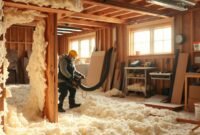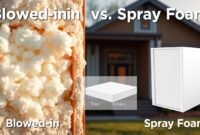Understanding what is blown-in insulation made of can give you a better-educated decision about what kind of insulation to expect for your house. This kind of insulation is great for delivering great energy-efficient and heat-resistant surroundings.
Basically, the insulation will prevent cool air from escaping your house and heat from coming to your house in summer or vice versa during winter. This insulation is perfect for cutting off your (cooling and heating) bills up to 20%. So, what should you know about this kind of insulation?
More about Blow-in Insulation
Traditional insulation, such as fiberglass batts and foam insulation boards, has been a standard type of insulation in many homes. However, blown-in insulation, also known as loose-fill insulation, offers a more versatile solution for home improvement, particularly in updated work or older attics.
This type of insulation typically includes materials like mineral fibers, cellulose insulation, and sometimes Styrofoam pellets. The ability to install blown-in insulation in hard-to-reach areas makes it a preferred choice for many homeowners seeking efficient insulation upgrades.
Read also: Comparison Between Fiberglass VS Cellulose Blown Insulation
If you are wondering what is blown-in insulation made of, it’s typically made of fiberglass, being used in around 90% of new houses.
Some manufacturers may use fiberglass (mineral) wool that is safer and non-toxic.

The installation involves filling out joist or stud cavities with the chosen (loose) material. Staff may use the so-called blower hose to spray out the fluffy and soft insulation material across the area of subjects. Another staff may feed the fiberglass mineral wool into a below unit or the exterior part of the house.
They will spread the (fiberglass) wool until the entire cavities are filled. It’s possible that the wool coating application should reach a certain thickness so it becomes effective for the insulation.
Types of Blow-in Insulation
There are 3 most popular and common blown-in insulation types. They are rock wool, cellulose, and loose-fill fiberglass. Depending on your geographic zone, these insulation types can help protect your house better.
Basically, a higher blown insulation R-value will provide a better insulation effect. Each type will come with a different thermal value. However, keep in mind that even little insulation is always better than nothing at all.
- Loose Fill Fiberglass
This insulation is claimed ‘light as air’. It’s made from heated glass to a liquid form and then formed into thin fibers. Applying this blown insulation type to wall and attic spaces can offer an R-2.5 thermal value (per inch) as the average standard.
Read also: Spray Foam Attic Insulation Pros and Cons
- Cellulose
This is often the common option for homeowners with an eco-friendly concept. It’s made from recycled newspaper or cardboard that is finely shredded. It has been treated chemically to avoid fire and mold.
However, one flaw of this insulation type is that it can absorb moisture. Once it gets wet, it becomes soggy, and it loses its fluffiness. It will be compacted too, leading to R-value reduction.
- Rock Wool
Also known as mineral wool, it is made from the so-called blast furnace slag. It’s a byproduct of iron ore and firing iron. To be rock wool, the slag must be heated, mixed with other minerals, and spun to a somewhat airy product.
The final texture will look like the raw wool of the sheep. This insulation has impressive fire resistance quality. That’s why it’s often used in areas prone to fire hazards, like the connecting wall between the attached garage and a house or for the floor.
Is Blown-in Insulation Unhealthy?
It takes extra precautions to handle fiberglass insulation. When disturbed or moved, it releases tiny particles, which can cause rashes, itching, and irritation. When inhaled, it can lead to nosebleeds, coughing, and respiratory issues.
That’s why you need to wear safety gear when handling it. Now that you know what blown-in insulation is, you can handle it with care and extra caution.


